Key Takeaways
- Via offers on-demand rides with a “corner-to-corner” shared ride approach.
- Drivers must meet specific requirements including a valid driver’s license and vehicle criteria.
- The application process involves submitting documents, vehicle inspection, and online training.
- Via provides competitive earnings, live support, and operates in select cities.
How Does Via Work?
Via operates similarly to Lyft and Uber by offering on-demand rides through a mobile app, where passengers schedule pickups, track their rides, and process payments digitally.
However, Via differentiates itself by adopting a “corner-to-corner” approach, similar to shared ride services like UberX Share or Lyft Shared.
This model involves multiple passengers sharing a ride, headed in the same direction, with the pickup and drop-off points located at corners within a block or two of their actual locations.
This system is designed to minimize detours and function akin to public transportation, making the service more efficient and reducing the number of miles driven.
For drivers, this means less vehicle wear and tear, potentially lowering maintenance costs and depreciation over time.
The Requirements Drivers Must Meet to Apply to Via
Before you can drive for Via, you need to meet both their driver and vehicle requirements. These are not difficult, but failing to meet them will make you ineligible to drive for Via.
Via Driver Requirements
All Via drivers must meet the following requirements:
- Have a valid driver’s license
- At least one year of U.S. driving experience
- Pass a criminal background check
- Possess a TLC license (for drivers in New York City). Note that Via can help you with this process, so you can still apply even if you don’t have a TLC license
Via Vehicle Requirements
In addition to these driver requirements, Via also has vehicle requirements that you’ll need to meet:
- Pass a vehicle inspection (for drivers in Chicago)
- Have a vehicle that meets your city requirements:
- New York City — TLC-licensed vehicle of any color that has a leather interior
- Chicago — Model year 2010 or newer for non-luxury vehicles and model year 2005 or newer for luxury vehicles
- Washington, D.C. — Model year 2010 or newer with a private (i.e., non-government) license plate
- Have valid vehicle insurance and registration
As you can see, the requirements for Via are not that complicated. In fact, they can even be simpler than the requirements for Uber or Lyft in some cases.
Via Driver Application Process
If you’re interested in driving for Via, you’ll have to go through the company’s application process. While the details will vary based on your city, the basic process is as follows:
1. Visit the Via driver application page
You can access this page by clicking this link. Once on the page, you’ll see a screen like the following:
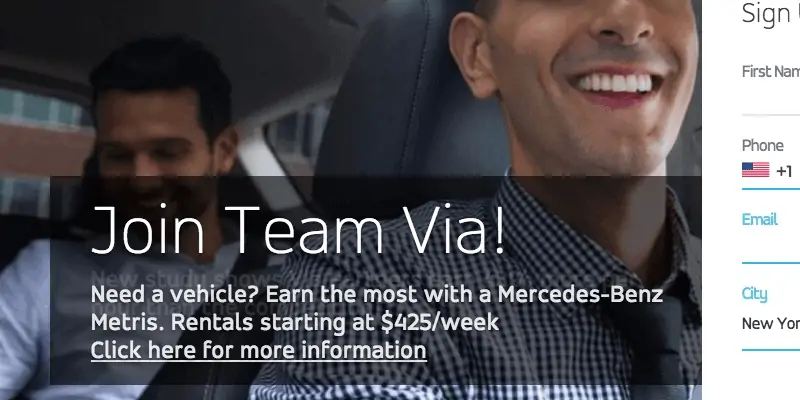
2. Fill out the application box
On the application page, you’ll see a box that says, “Sign Up.”
In this box, select your city from the list, and then enter the following information:
- First name
- Last name
- Phone number
- Email address
This will not only start the application, but it will also create an account that you can use to check your application status, as well as resume your application if you need to take a break in the midst of it.
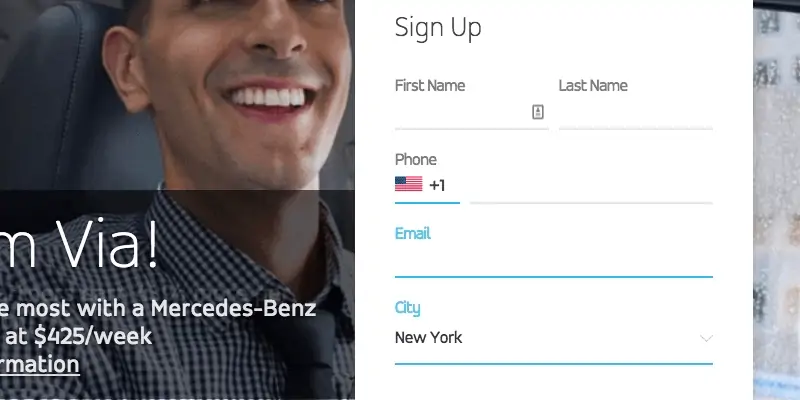
3. Answer a series of questions
Next, you’ll need to answer some questions to determine if you’re eligible to drive for Via. These include:
- How long have you been driving in the U.S.? (less than or more than a year?)
- What sort of vehicle will you be using for Via? (personal vehicle, taxi, or you don’t have a vehicle)
- Vehicle make, model, color, and year
- Vehicle license plate number
You’ll also need to consent to a background check and arrange for a vehicle inspection (if necessary). If you’re in NYC, you’ll need to answer some questions about your TLC license.
Assuming your answers to these questions satisfy Via’s requirements, they’ll process your application. They don’t say how long this generally takes, but given that the platform is still relatively small, it shouldn’t be long.
4. Upload the required documents
Once Via has approved the basics of your application, you’ll need to upload certain documents.
This includes a copy of your driver’s license, proof of insurance, and vehicle registration. If in NYC, you’ll need to upload a copy of your TLC license.
You’ll also need to add your bank account and tax information so that Via can pay you (and verify that you can legally work in the U.S.).
5. Undergo a new driver orientation
Via is vague about the extent of this process, but new drivers presumably receive some sort of orientation and training before their first trip.
Via New Driver Bonus/Sign Up Bonus: Claim Yours Now
One great perk of driving for Via is the new driver sign up bonus that they offer. The details of the bonus vary based on your city.
In Chicago, for instance, there’s an earnings guarantee of $1,000 if you complete 100 rides in your first 30 days. In NYC, on the other hand, you can receive a signing bonus of up to $2,000.
Finally, drivers in Washington, D.C. can receive “huge guaranteed fares” (fill out an application to see details). Curious how to get free rides as a Via passenger?
Check out our passenger guide to find out.
How Much Do Via Drivers Make?
Via drivers have the potential to earn more than they might with Uber or Lyft due to Via’s unique compensation structure and lower commission rates. Earnings vary by city and driving frequency.
Via incentivizes drivers for carrying multiple passengers, contrasting with Uber and Lyft, where shared rides often yield lower earnings than individual rides.
Via offers two earning modes: Flex Mode, which pays drivers based on distance and time, along with surge pricing through Rocket Pay; and Blue Mode, where drivers earn a flat hourly rate regardless of passenger count or ride frequency.
Blue Mode provides income stability, a notable difference from the variable earnings of Uber and Lyft.
Via’s commission rates are lower, at 15% in Chicago and D.C., and in NYC, 10% for Blue Mode and 20% for Flex Mode rides, compared to Uber and Lyft’s higher fees.
Additionally, the platform riders to tip drivers, offering an extra earning incentive for excellent service.
After Approval: Understanding the Via Driver App
We’d like to include a bit about how the Via Driver App works.
It’s simple to use, and it will be a familiar experience if you’ve used the Uber or Lyft driver apps.
The app is available to download for Android and iOS.
While you can download it at any time, you won’t be able to use it until Via has approved your application and received all the necessary documents.
Once you start driving, you’ll be able to see passenger requests pop up much like they would with Uber or Lyft.
To accept a passenger request, simply tap “Accept.”
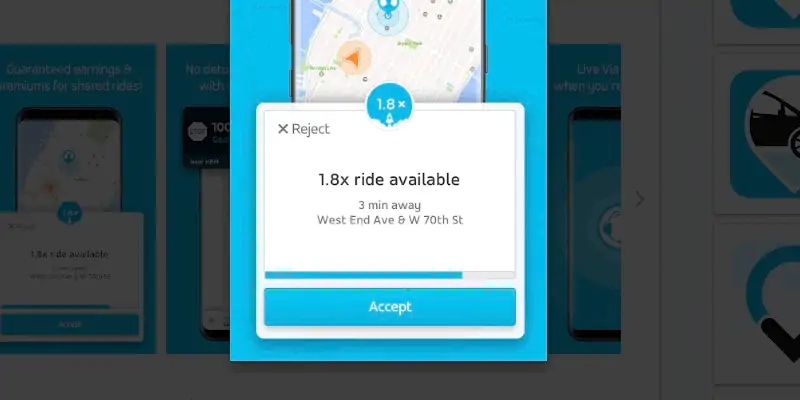
Once you’ve accepted the request, you’ll need to pick the passenger up.
Note that, unlike Uber or Lyft, with Via you always drive in one direction and pick up passengers at corners.
This makes the process much easier than other rideshare platforms.
The app will give you directions to the passenger’s location, as well as landmarks to look for:
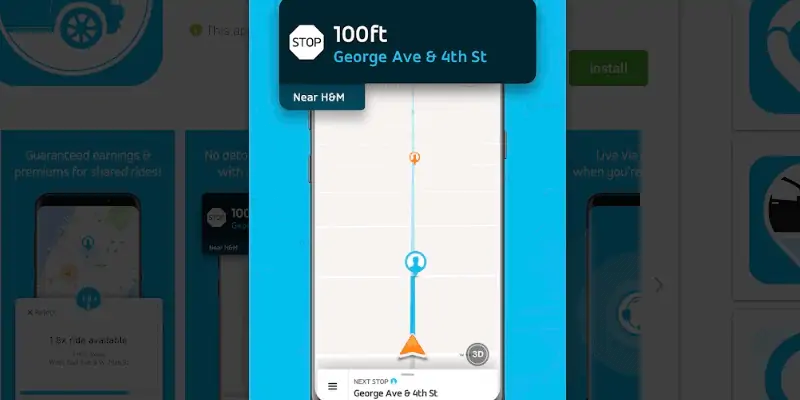
Once you’ve picked the passenger up, you’ll get directions on where to drop them off (and you may pick up other passengers on the way).
Via Driver Support
Besides the higher earning potential, Via offers a level of driver support that sets them apart from Uber and Lyft.
All drivers get live support via phone or text for help with any ride issues.
This level of real-time support just isn’t present in Uber and Lyft (and certainly not as accessible as Via makes it).
Of course, the fact that Via is a much smaller company helps with this, and there’s no guarantee that they’ll be able to provide this level of support as they expand.
For now, however, the support Via offers drivers is another reason to switch from Uber or Lyft.
Best Cities for Via
Before you get too excited about driving for Via, you need to be sure you’re in a city where they operate.
In the United States, you can apply to drive for Via in the following cities:
- Chicago
- New York City
- Washington, D.C.
Additionally, Via is available in West Sacramento, CA, and Arlington, TX through partnerships with city governments. You can’t directly apply to drive for Via in these cities.
In Europe, Via also operates a service called ViaVan. It’s available in London and Berlin. You can learn more about it here.
From the perspective of service fees, it’s better to drive in Chicago and D.C. than NYC (assuming you’re doing Flex rides).
The additional TLC licensing requirements also make it trickier to start driving for Via in NYC (though if you’re already an Uber or Lyft driver, you’ll have the necessary license).
Frequently Asked Questions
Can I drive for Via at the same time as Uber and Lyft?
You cannot simultaneously use the Via app alongside Uber and Lyft due to Via’s operational setup. However, as an independent contractor, you’re free to work for Uber and Lyft when not active on Via’s app.
Experimenting with driving for a combination of these services versus exclusively for Via can help determine what’s most beneficial for you.
Can I drive for Via if I don’t own a car?
Yes, Via offers a vehicle leasing and rental program through partnerships, enabling those without a car to find one to lease or rent for driving on the Via platform. Consider the cost-benefit of leasing or rental fees against potential earnings to decide if this option suits you.
Does Via offer benefits like health insurance or retirement?
No, they do not. Via drivers are still independent contractors, and this means that you’re responsible for saving for and filing your own taxes, as well as paying for your own expenses.
Does Via have a driver referral program?
Yes, they do. You can earn a cash bonus when you refer new drivers to Via and they sign up for the platform using your referral link. The amount you can earn varies based on your city and is subject to change at any time.


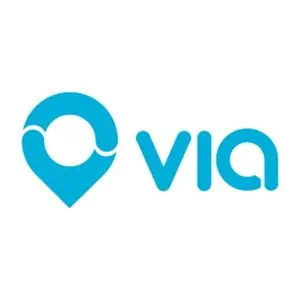
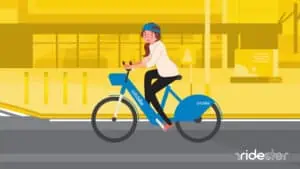
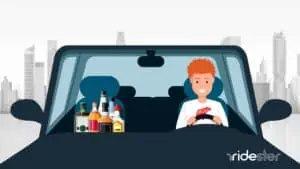
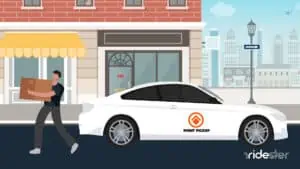

How far do backkground checks go?
Time from first application to actually driving was 6 months and communication from Via throughout the process was poor. Response and support while driving for Via is quick though.
The software has daily glitches, sometimes causing passengers to ride all over town, taking the driver in circles, or requiring the driver to drop off passengers in unsafe places or across the interstate from their destination.
If a passenger complains the driver gets suspended. Suspensions take about a week to resolve, even when the issue was caused by the software.